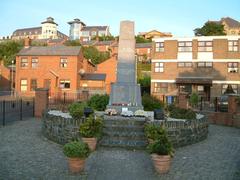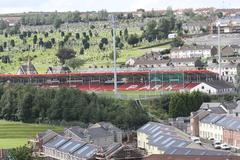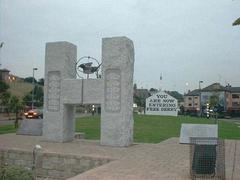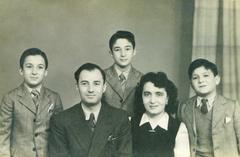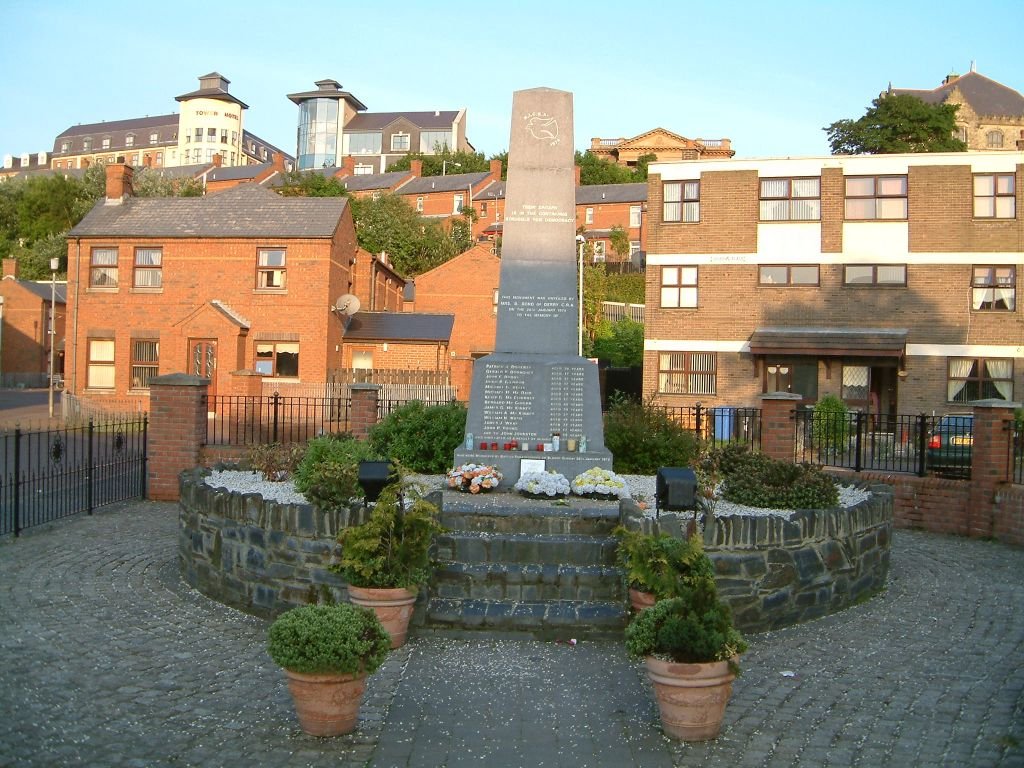
Complete Guide to Visiting Bloody Sunday Memorial in Derry, Northern Ireland: Tickets, Hours, and Tips
Date: 14/06/2025
Introduction
The Bloody Sunday Memorial in Derry, Northern Ireland, stands as a powerful tribute to the fourteen unarmed civilians killed on January 30, 1972, during a peaceful civil rights march. Situated in the heart of the Bogside, this site is a symbol of remembrance, resilience, and the community’s ongoing pursuit of justice. This comprehensive guide provides essential historical context, practical visitor information—including hours, ticketing, accessibility, and tours—and tips for a respectful and meaningful visit. Whether you are a history enthusiast, traveler, or someone seeking to better understand the legacy of the Troubles, this article will help you plan your visit effectively.
For further details and updates, consult the Museum of Free Derry and articles such as The Irish Road Trip.
Table of Contents
- Introduction
- Historical Background: Bloody Sunday and Its Significance
- The Memorial: Location, Design, and Symbolism
- Community Involvement and Ownership
- Practical Visitor Information
- Cultural Legacy and Ongoing Significance
- Frequently Asked Questions (FAQ)
- Summary and Final Tips
- References
Historical Background: Bloody Sunday and Its Significance
On January 30, 1972, a civil rights march in the Bogside area of Derry protested internment without trial—a policy that disproportionately affected the Catholic and nationalist community. As demonstrators approached British Army barricades, soldiers from the 1st Battalion Parachute Regiment opened fire, killing thirteen people instantly and fatally wounding a fourteenth. This event, known as Bloody Sunday, became the deadliest mass shooting in Northern Ireland’s history and a defining moment in the Troubles, a conflict that shaped the region for decades (The Irish Road Trip).
The initial Widgery Tribunal largely exonerated the soldiers, sparking outrage and accusations of a whitewash. Decades later, the Saville Inquiry finally acknowledged the victims’ innocence, leading to a formal apology from the UK Prime Minister in 2010. Bloody Sunday galvanized activism, influenced cultural works, and remains a watershed in the struggle for justice and peace in Northern Ireland (The Irish Center).
The Memorial: Location, Design, and Symbolism
The Bloody Sunday Memorial stands on Rossville Street in the Bogside neighborhood, adjacent to Glenfada Park and within walking distance of Derry’s city center and historic walls (Museum of Free Derry). Its location is deeply significant, marking the ground where several victims fell and where the community continues to honor their memory.
Erected in 1974—just two years after the tragedy—the monument is a stone obelisk inscribed with the names and ages of the fourteen victims. Its simple, dignified design was funded and built by the local community, reflecting their determination to memorialize the event on their own terms (Nanovic Institute). The surrounding area features murals depicting scenes from Bloody Sunday and the Troubles, making the site a focal point for reflection and education.
Community Involvement and Ownership
The creation and ongoing stewardship of the memorial are the work of local families, activists, and the Bloody Sunday Trust. These grassroots efforts ensured that the community’s voice was central in how the tragedy was remembered. Annual commemorative events on January 30th draw attendees from Ireland and beyond, reinforcing the memorial’s role as both a site of mourning and a rallying point for calls for justice (Museum of Free Derry).
Practical Visitor Information
Visiting Hours
The Bloody Sunday Memorial is outdoors and accessible to the public 24 hours a day, year-round. For the best experience and safety, visiting during daylight hours is recommended.
Tickets and Admission
Visiting the memorial is free of charge—no tickets or reservations are required.
For those seeking a deeper understanding, the nearby Museum of Free Derry offers a comprehensive exhibition.
Museum Hours:
- Monday to Friday: 9:30 am – 6:00 pm
- Weekends: 10:00 am – 4:00 pm (last entry one hour before closing)
Admission Fee:
- Adults: £8.00
- Concessions available
Accessibility
The memorial is situated on flat, paved public streets and is wheelchair accessible. While the main site is accessible, be mindful that some surrounding areas feature cobblestones and uneven surfaces. The Museum of Free Derry is also fully accessible.
Getting There and Travel Tips
- Location: Rossville Street, Bogside, Derry/Londonderry
- From City Center: Short walk; follow signs or use a city map
- Public Transport: Local buses stop near Guildhall and city center
- Parking: Limited on-street parking; public transport is recommended
- Best Time to Visit: Weekdays and daylight hours for a quieter, more reflective experience
Guided Tours and Special Events
Guided walking tours of the Bogside, including the memorial, murals, and Free Derry Corner, are offered by local organizations. Many guides have personal connections to the events, enriching the visitor experience with firsthand perspectives (Go-to-Ireland.com). Tours typically last 1.5–2 hours and can be booked in advance.
Annual commemorations on January 30th draw large crowds and feature readings, music, and moments of silence (Derry Journal).
Nearby Attractions
- Museum of Free Derry: Immersive exhibitions on the civil rights movement and the Troubles
- Free Derry Corner: Iconic wall symbolizing resistance
- Bogside Murals: Powerful artwork depicting key moments in Derry’s history
- Derry City Walls and Guildhall: Historical landmarks within walking distance
Cultural Legacy and Ongoing Significance
The Bloody Sunday Memorial is a living site of memory and activism. Annual events and guided tours keep the victims’ stories alive and foster dialogue about justice, accountability, and peace (DerryNow.com). The memorial also serves as a platform for expressing solidarity with global struggles for human rights, linking local history to broader movements.
The site’s cultural resonance is evident in music, poetry, and ongoing campaigns for justice, such as opposition to restrictive legacy legislation. Visiting the memorial offers a powerful opportunity to reflect on the past and engage in the ongoing journey toward reconciliation.
Frequently Asked Questions (FAQ)
Q: What are the Bloody Sunday Memorial visiting hours?
A: The memorial is open to the public 24/7 as it is an outdoor site.
Q: Is there an entrance fee or ticket required?
A: No, visiting the memorial is free and requires no ticket.
Q: Are guided tours available?
A: Yes, guided walking tours are available year-round and can be booked in advance through local operators or visitor centers.
Q: Is the memorial wheelchair accessible?
A: Yes, the site and nearby museum are accessible, but some surrounding streets may be uneven.
Q: What other attractions are near the memorial?
A: The Museum of Free Derry, Free Derry Corner, Bogside Murals, and Derry’s historic city walls.
Q: When is the best time to visit?
A: Daylight hours are recommended. The annual commemoration on January 30th offers a unique experience.
Q: Can I take photographs at the memorial?
A: Yes, but please be respectful, especially during commemorative events.
Summary and Final Tips
Visiting the Bloody Sunday Memorial is a profound experience, offering insight into a pivotal event in Northern Ireland’s history. The site is open year-round, free to access, and located near other key historical attractions. For a deeper understanding, consider joining a guided tour and visiting the Museum of Free Derry. Always approach the memorial and surrounding murals with sensitivity—this is a living site of memory for many in the local community.
For the latest information, downloadable audio guides, and updates on tours or events, explore resources like the Audiala app and the official Museum of Free Derry.
References
- The Irish Road Trip
- Nanovic Institute
- The Irish Center
- Go-to-Ireland.com
- Derry Journal
- DerryNow.com
- Museum of Free Derry
